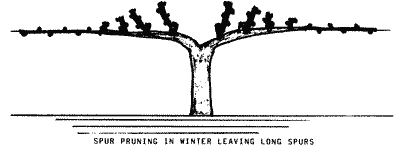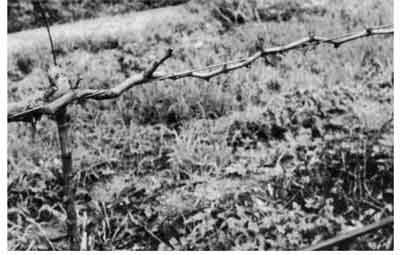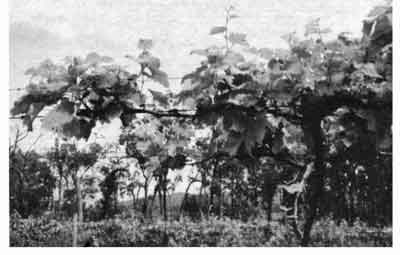
PRUNING TABLE GRAPES IN THE TROPICS
SCIENTIFIC NAME:Vitis vinifera
FAMILY: Vitaceae
This is a bit complicated, but I'll try to explain it as best I can. Apparently not all varieties crop well under tropical conditions, but some do reasonably well, e.g. Black Muscat and Flame Seedless on the Tableland, and no doubt there are others too, and in hotter areas, Ribier (Alphonse Lavallee), Maroo seedless (MS 23-7) and Royal Ascot. I am not familiar with the last variety unless it has a synonym. The pruning of these varieties is as follows:
WINTER PRUNING
Most table grape varieties fruit on spurs arising from the arms of the vine. So the style of pruning is commonly called "spur pruning on permanent arms" as illustrated:

Because some table grape varieties in the tropics apparently are more fruitful on buds further out on the canes, spur pruning in winter aims to leave around three or four bud spurs. Some varieties may fruit well enough on two bud spurs and I guess others may even fruit better on longer spurs or even short rods. Much more work needs to be done, especially with some of our popular seedless varieties under tropical conditions. Thompson Seedless (Sultana) would certainly be better rod pruned as it is down south.
The bud burst problem after winter pruning
As we don't get enough winter chilling, there is a problem of achieving even budburst after winter pruning. This necessitates the use of a Cyanamide formulation (Dormex) which is painted on the buds with a brush (sprayed on commercially) four to six weeks before normal bud break. This breaks dormancy and gets all the buds growing away together at the same time. If Dormex is not applied in this way, all that happens is that only the end bud on the arm shoots and grows away very vigorously but nothing else bursts, even the buds on the spurs remain completely dormant all year. I am not aware that Dormex is sold in small pack sizes for backyarders yet.
After bud burst in late winter/spring, the vine flowers and sets its fruit.
Timing of operations
It would be advantageous if the timing of all these operations would be such as to allow the vine to grow, flower, set and ripen its fruit before the summer monsoon rains, as heavy rainfall would certainly split the ripe berries.
The need to restore vine structure in summer
There are problems with maintaining vine structure due to the long spurs left after winter pruning in some varieties. If these long spurs are left until next winter, the spur arms eventually become too long and unmanageable. This then necessitates pruning again in summer to restore vine structure.
SUMMER PRUNING
This is usually done four to six weeks after the crop has been picked, around November or December. With this pruning, the original four- or five-bud spur is reduced to around two buds or even one bud and a base bud for better shape as pictured.
 |  |
| Vine summer pruned on 12.12.'91 | Shoot growth 28 days later |
As this vine is still being formed, notice the arm has been extended along the wire using a twelve-bud, extension cane. If further extension is needed in future, the end bud of this cane must point downwards so that it grows out along the trellis wire and not up in the air! At the same time as the vine is pruned, every leaf has to be cut off as well, to get the buds to shoot.
All the buds will now grow away vigorously at this time of year without any need to use Dormex again. The growth that they make from December onwards will be either short- or long-spur pruned again in the following winter according to the needs of the particular variety.
Due to our warm climate and much longer growing season in the tropics, these shoots have ample time to make strong wood for pruning back again in winter.
In Thailand, somewhere west of Bangkok, I have seen blocks of table grapes in all stages of development. Some in full crop, some pruned and others in growth, all growing next to each other. This seems to indicate that table grapes can be successfully grown and cropped continuously in the tropics! Whether we can do the same in Cairns remains to be seen, but I should imagine it would be possible to crop grapes this way in Darwin, as that area is roughly the same distance south as Bangkok is north of the Equator. However there is still the problem of split berries in times of heavy rainfall.
DATE: March 1992
* * * * * * * * * * * * *
